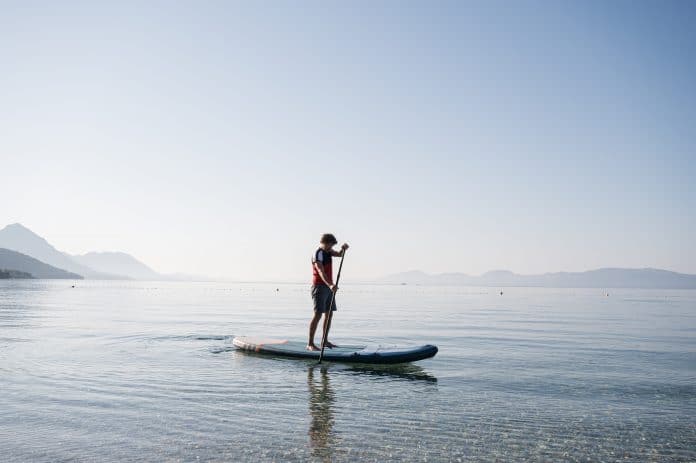Want to widen your range of fishing opportunities but not ready for a boat yet? Then a SUP or Stand Up Paddleboard may be your best bet!
Portable, durable, lightweight, stealthy, and affordable, SUPs are one mighty alternative to the kayaks and canoes that we’ve all accepted as personal fishing vessels.
If it’s not raining or blowing out there, get your SUP out and start catching some fish!
Benefits of Inflatable SUP boards
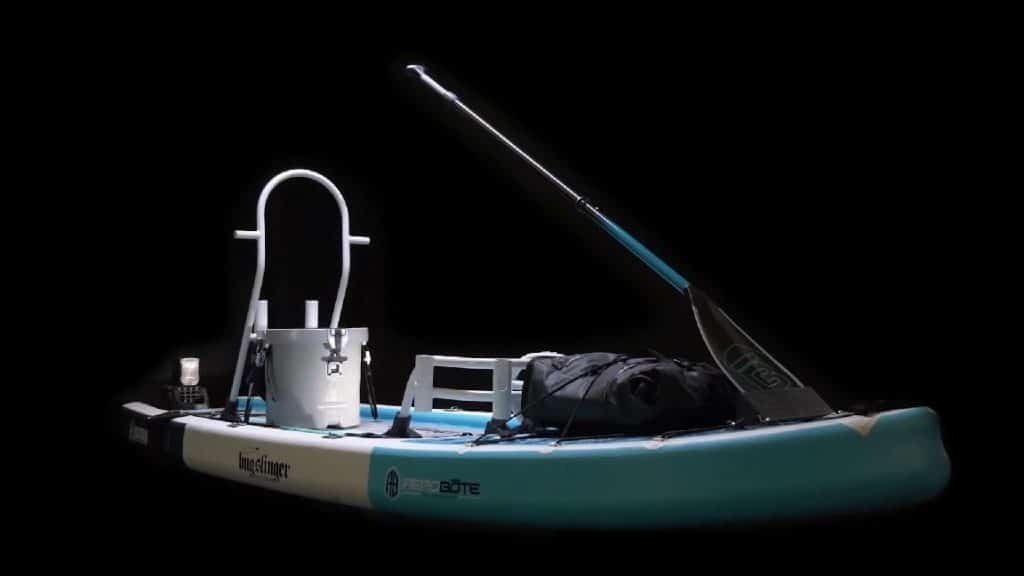
Portability
Arguably the best benefit of having an inflatable SUP is the ability to take it anywhere! Whether you are headed to the local bass pond or reservoir or exploring remote islands and salt flats in the tropics, your inflatable SUP can be easily transported and set-up solo.
Inflatable SUPs’ footprint when deflated is comparable to a large suitcase. With an average weight of 20lbs, it doesn’t require too much effort to load and unload in your vehicle’s boot.
Most bags will come with wheels so users can just roll the bag in airports, on parking lots, or at launching areas.
Having everything you need in one bag is the pinnacle of convenience. Your board, its fins, the paddle, the pump, and other board accessories all fit into one bag, minimizing the chances of losing pieces and accessories.
Fishing locations are limited to your SUP experience and skills. From bass fishing at your local pond to flats fishing for bonefish in Belize, if you’re adventurous enough, your SUP can help you find the fish.
Vision
The eyes are a very important tool for fishing. Searching for structure, bait, birds, sight casting and just plain seeing things around you are key for maximum fishing success.
On SUPs, your vision is maximized as you are in a standing position almost all the time. If you are brave and experienced enough, you can also stand on your esky for added elevation.
SUPs started gaining popularity among fishermen almost a decade ago when kayak fishing was the rage. In kayaks, your vision was limited as you were seated and close to the water. Although there were fishing kayaks that allow anglers to stand up for sight casting purposes, the SUP is seen as a more efficient and ergonomic alternative to the kayak.
Stealth
The ability to sneak up on unexpecting fish in skinny water is only limited to personal watercraft like kayaks, canoes, belly floats, and SUPs.
It is hard to explain how amazing it is to be able to get within an arm’s length to your targeted fish without it noticing. You’d have to experience this yourself. The feeling is surreal.
Fishability
Standard SUPs provide users with a large, stable, and flat platform to fish on. Anglers have space for an esky, a storage crate for your tackle, ropes and drift sock, and one or two rods.
This flat platform minimizes things that you can hit when casting, so you can send your casts without any worries. Apart from worrying about falling over when you lose your balance.
Landing a fish on a SUP is a bit of a challenge at first, as you need to lower yourself to a kneeling position to land a fish without tipping over, or breaking the tip of your rod. But maneuvering yourself on your SUP will come with enough practice and experience.
The Downsides of SUPs
SUPs are significantly cheaper than real boats, but in the end, no matter how hard we try, they are not real boats.
You get the portability, vision, stealth, and the ability to fish skinny water with minimal cost, but you sacrifice a lot as well.
Minimal Load Capacity
You are fishing on an enlarged version of an inflatable surfboard. A virtually flat balloon, directly on the surface of the water, with no gunwales to prevent water from splashing onto the SUP.
You will be able to bring a limited amount of gear, as mentioned previously in the Fishability section of this article, an esky, a utility crate, some tackle, and one or two rods at the most. Anything more and you risk overloading the SUP and cause instability and risk losing a lot of gear!
A minimalist approach to tackle and gear is required if you want to fish successfully on a SUP.
Limited Fishing Coverage
Let’s be honest. No matter how fit of a paddler you are, you won’t be able to cover as much water as Jed on a tinny with a 15hp outboard with 25L of fuel in the jerry.
Your paddling distance will be limited not only to your physical fitness levels, but you’ll also be challenged by the weather, specifically wind, waves, and current.
Waves higher than 6 inches will be a challenge to paddle through without bailing, more so trying to get a perfect double haul to land on the nose of a rampaging GT. Imagine the chaos when trying to set the hook!
Arguably the best benefit of having an inflatable SUP is the ability to take it anywhere! Whether you are headed to the local bass pond or reservoir or exploring remote islands and salt flats in the tropics, your inflatable SUP can be easily transported and set-up solo.
So, you still want to SUP?
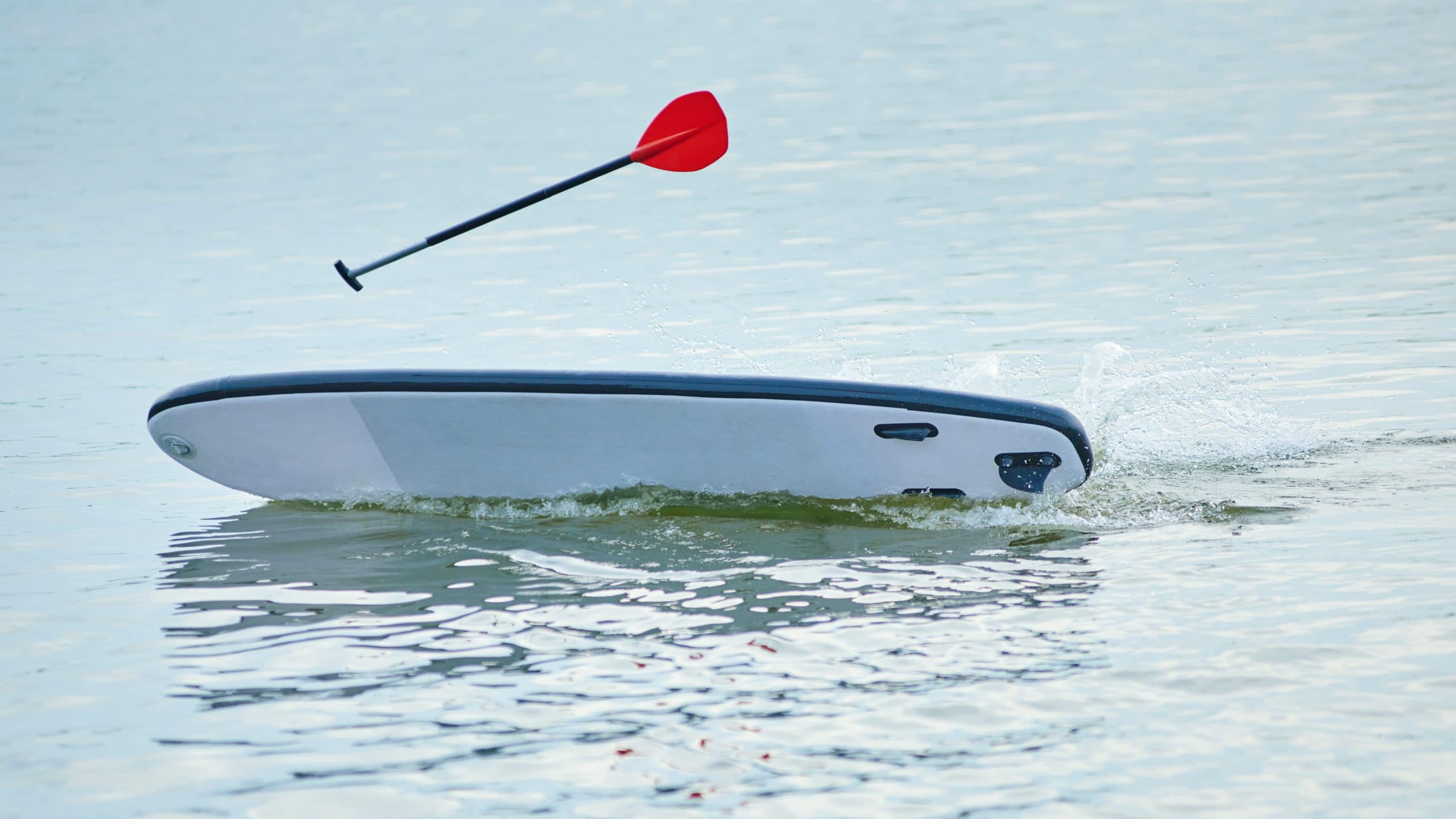
After you’ve read all the benefits and limitations of SUP fishing above, and you feel a SUP would be a great primary floatation device for your fishing adventures, then let’s list down some ‘must do’s’ so you won’t look stupid in front of your mates and get them envious of your SUP fishing instead.
- Practice, practice, and keep practicing.
Start slow then add miles as you get better. Leave your fishing gear at home during your first attempts. Try to get the basics down pat first before attempting to bring along a rod. Once you perfect launching, standing up, balancing, and paddling with and without wind, then you can bring ‘one’ rod with you and a small sling bag with a box of lures or flies. Conditions always change and getting your on water hours in will only make you a better SUP handler and angler.
Master standing up and getting back down on your knees. You’ll need this skill when landing a fish and getting back to casting.
- Safety First!
Always wear a life jacket or PFD. In most countries, SUPs are considered personal watercraft, and users are required to wear some sort of personal floatation device with a whistle. No matter how good of a SUP-per you are, a PFD is always a must! Accidents happen, and we don’t want to test Mother Nature and what she has in store for unprepared anglers. When heading out on a solo mission, it is best to let your family or mates know where you will be fishing, and when you expect to head back home. Phones are essential in emergencies. Luckily, modern smartphones are waterproof and you should always bring your phone with you no matter what. If your phone isn’t waterproof, put it in your dry-bag for safe-keeping.
- Check the Weather!
Days, when there are barely any winds, are always best. Flat calm water is ideal for SUPs where the craft just glides without any effort. Glassy calm conditions will allow you to cover more distance with the most confidence and will also let you focus on the fishing rather than trying to stay afloat! Remember that SUPs are a slave to the wind. If it is blowing offshore, just forego the SUP and trek the coastline for some land-based fishing instead.
- Take the Minimalist Approach to Gear.
Take with you only what you know you will use. A one-rod set-up should be all you need for a day’s SUP fishing mission. Choose your targets, set your goals, and stick to them. A box of lures or flies that will cover most scenarios will be enough. A small esky at the back plus a utility crate up front for ropes, drift socks, flare and other safety equipment should keep things sweet.
- Strap things down.
Use the bungee cords included to strap your esky and utility crate down. Loose things on your SUP will fall overboard. Fishing specific SUPs will have designated tie-down points for eskies and utility crates, so make use of them.
- Strap yourself to your paddle and onto your board.
Use the SUP’s tether and always strap it to your leg. When you fall off your board, you wouldn’t want to choose between swimming after it or saving your esky and fishing gear would you? Save yourself the trouble and always tether your paddle and board.
- If possible, hop in the water and wade.
SUP fishing is ideal for calm, protected water with plenty of shallow wadeable flats or banks. Think of the SUP as the mode of transporting yourself to a better patch of water, than a designated fishing platform. Get to the spots, get off the SUP, and wade. Since your board is tethered to you, you are free to wade and fish to your heart’s content, while your board and gear are all within arm’s reach. Your transportation and oversized tackle tray all in one.
- Choose your SUP wisely.
Yes, any SUP board can work. But getting yourself a purpose-built fishing SUP can make things easier and better for you in the long run. Fishing SUPs are built wider and longer, with consideration for your gear. Many fishing SUPs come with plenty of lashing points, tie-down points, and accessory slots for rod holders and other paraphernalia. Sometimes it is wiser to forgo the DIY route and just get a purpose-built fishing SUP. Spending the extra bucks is sometimes the better choice.
Top 3 SUP Recommendations
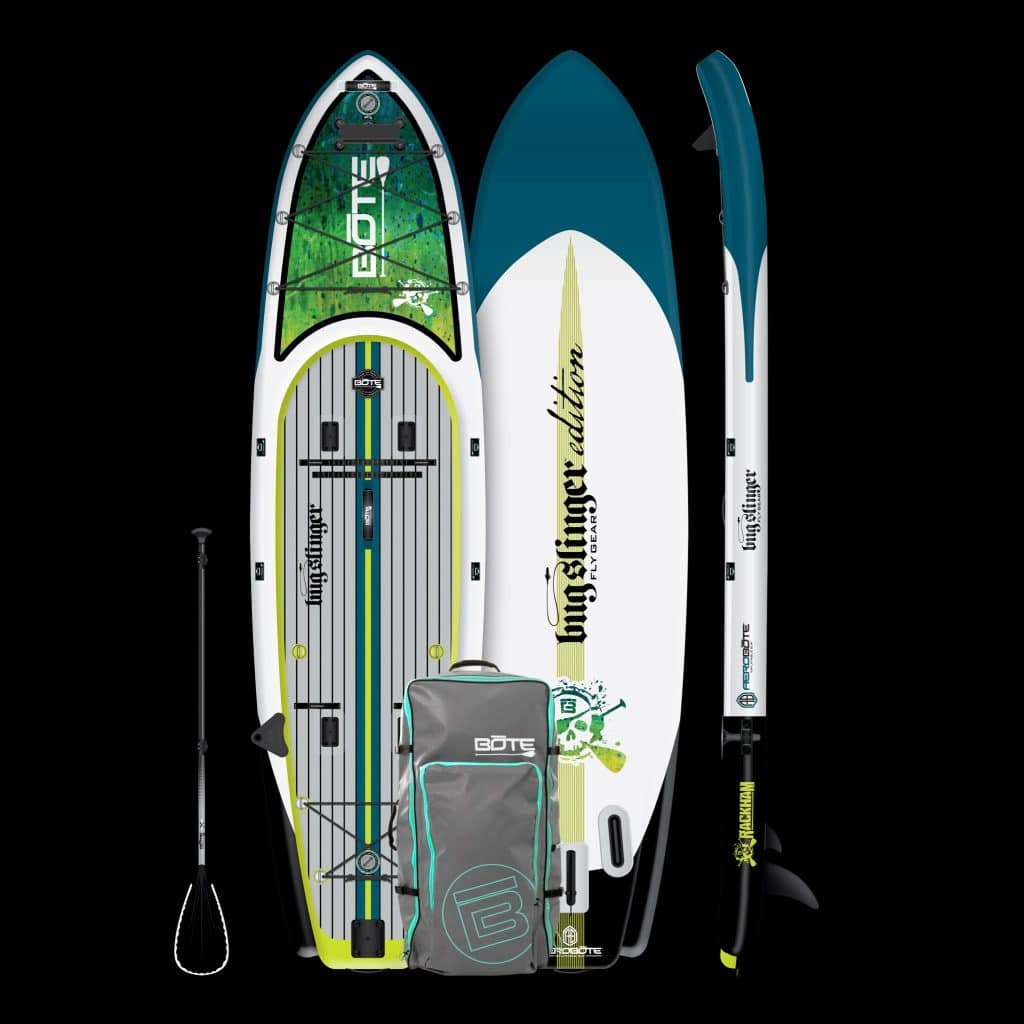
1. Bote Rackham Aero Inflatable Paddleboard
At 12’4” long and 38” wide, the Rackham by BOTE is a floating base camp of a fishing rig. It is extremely stable and can take plenty of gear on-board. It is a purpose-built fishing machine with accessory slots called Rac Receivers for rod holders and gear racks. My favorite feature is the paddle sheath, where you can stick your paddle in to free your hands for other tasks.
All of BOTE’s inflatable boards are dual-chambered, allowing for maximum air capacity and stability. BOTE also utilizes military-grade PVC which is virtually indestructible! The inner core of our AeroBOTEs has tens of thousands of composite fibers that connect the top and bottom halves of the board and when under pressure create solid board rigidity. Add on the 2-year warranty and you’ve got a bargain! The Rackham’s roller bag is near bulletproof and is ideal for both local and international SUP fishing adventures.
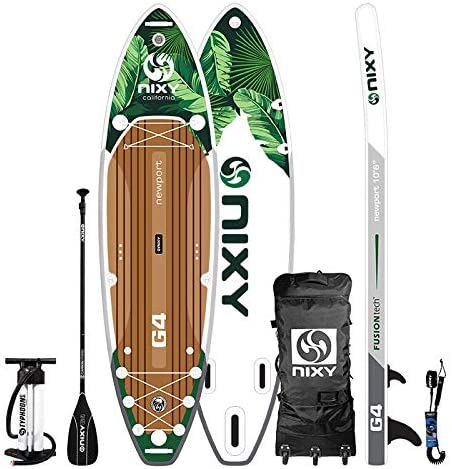
2. NIXY Newport Inflatable Paddleboard
10’6” long and 33” wide, the NIXY Newport is a great all-around SUP for exploring your favorite fishing holes. The Newport fits right in the middle in terms of performance and cost. Its lack of fishing-specific features may just be the best part of this SUP as it will force you to minimize the gear you bring on your fishing missions. But this doesn’t mean that it cannot take a heavy load!
The NIXY Newport comes with an adjustable carbon-fiber hybrid paddle, detachable fins, hybrid coiled leash, dual-chamber triple action hand pump, repair kit, and a multifunctional backpack. A 2-year warranty is also inclusive of your purchase of a NIXY Newport. Everything you need to get started.
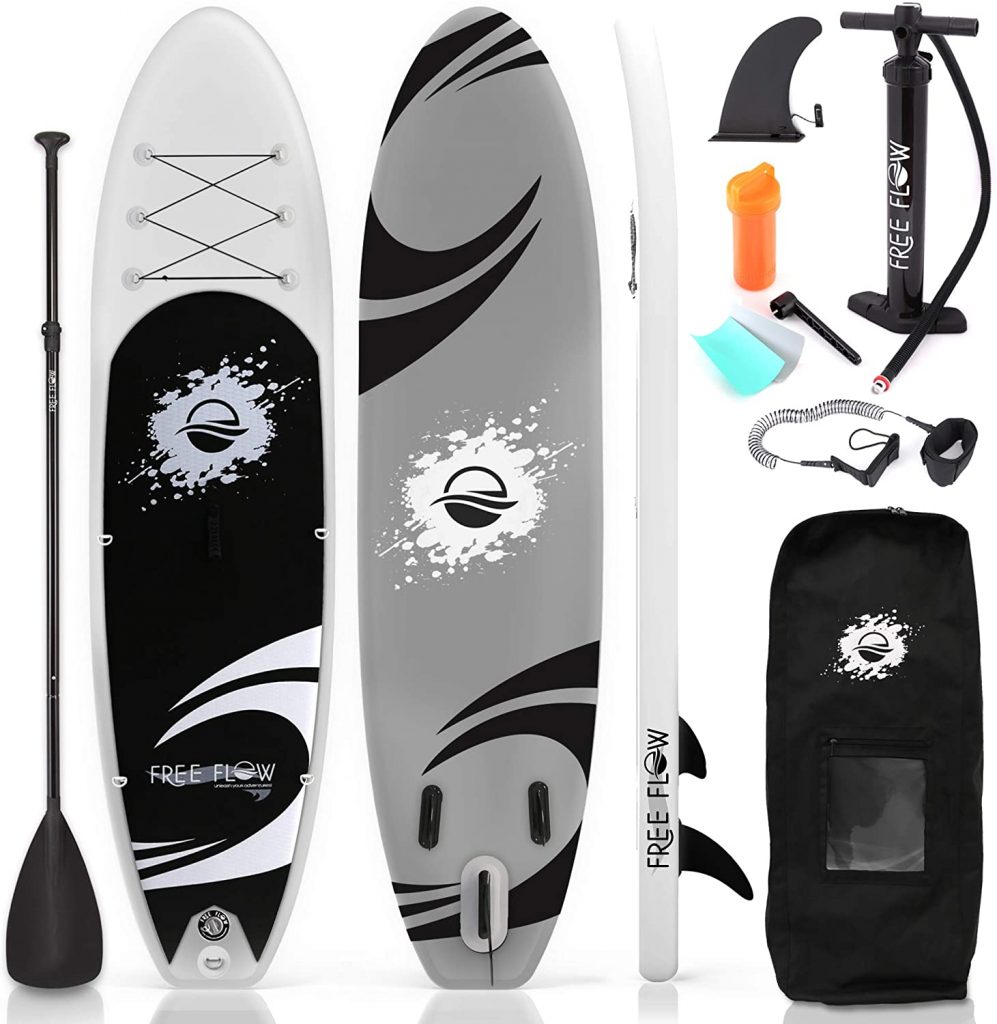
3. SereneLife Free Flow Inflatable Paddleboard
If you are looking for something easy on the wallet to start your SUP fishing journey, the Free Flow SUP may be the best deal out there. 10’6” long and 32” wide, this board is plenty stable and is suitable for beginners. Storage is limited to bungee cords up the front, so a “backpack and one rod” setup will be the go with the Free Flow. More suited for practice and getting your sea-legs under you than for full-blown fishing adventures in the tropics, the Free Flow is the perfect starting point to your SUP fishing journey.
Last Cast
If you want to widen your range of fishing opportunities but you’re not quite ready for a boat yet, a small personal watercraft could be your best bet. Kayaks and canoes can offer your storage, safety, reliability, and efficiency but they can be a pain to transport and unless they are inflatable, you can’t bring them with you everywhere.
SUP fishing may not be for everyone, as it requires some skill to do successfully. If you’re a surfer or have surfed before, you may have found your next fishing machine. If you’re someone with two left feet, a lot of practice in your pool or a shallow pond is a must before you paddle in public.
As I always recommend when purchasing any sort of fishing gear, always purchase the best that you can afford. The same goes for your SUP.
Inflatable SUPs take some practice to get used to but in time, and the right hands (and feet) it can turn into one venerable fishing machine that can reach the skinniest of waters and the spookiest of fish, all whilst carrying it on your back, all done solo, surrounded by nature and in complete serenity and bliss.


